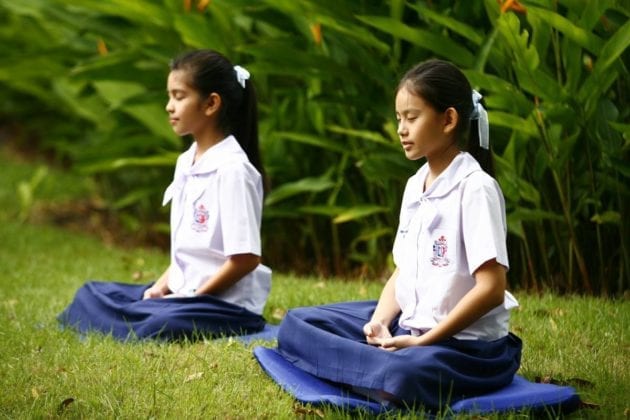 Healthy kids are generally bombastic blurs of energy. I’d bet everyone a stack of pancakes that it would be unreasonable to expect their kids to sit still, unstimulated, for five minutes. But teaching children meditation isn’t impossible. My five-year-old daughter Sky, who is like a walking Broadway musical, does it twice a day. If she can do it, your child can, too.
Healthy kids are generally bombastic blurs of energy. I’d bet everyone a stack of pancakes that it would be unreasonable to expect their kids to sit still, unstimulated, for five minutes. But teaching children meditation isn’t impossible. My five-year-old daughter Sky, who is like a walking Broadway musical, does it twice a day. If she can do it, your child can, too.
I’d imagine that the mere idea of teaching children meditation seems pretty weird to most people in southern Utah. In the West, prayer is about as close as we get to it, and that — if we’ll be honest with ourselves — is largely asking for things, even if they aren’t for ourselves. There’s nothing wrong with prayer, of course, and some forms of prayer and meditation do resemble each other in ways. However, most forms of Buddhist meditation are generally the opposite: training oneself to ask for nothing and accept everything as it is rather than petitioning some external entity for change. Sometimes it’s lumped together with prayer as a “contemplative discipline”; however, the idea is really not to contemplate anything. Prayer and meditation both have value, but they’re also very different, and one seems relatively normal in 2016 America while the other is often misunderstood.
 There are a lot of kinds of meditation. When I discuss teaching children meditation in this setting, I’m talking about straight-up Zen. That’s the Japanese word for “chan,” which is the Chinese word for “dhyana,” which is the Sanskrit word for meditation. Call it zazen, shikantaza, shamatha, or vipassana: I’m talking about meditation that involves silence, stillness, and concentration. (I’m not talking about listening to some lady whisper sweet nothings over an Enya soundtrack so we can feel blissed-out for 15 minutes.) In secular contexts in the West, these techniques are generally lumped together and often referred to generally as mindfulness meditation, mindfulness training, or even Mindfulness-based Stress Reduction (MBSR). I’ll just refer to it as meditation.
There are a lot of kinds of meditation. When I discuss teaching children meditation in this setting, I’m talking about straight-up Zen. That’s the Japanese word for “chan,” which is the Chinese word for “dhyana,” which is the Sanskrit word for meditation. Call it zazen, shikantaza, shamatha, or vipassana: I’m talking about meditation that involves silence, stillness, and concentration. (I’m not talking about listening to some lady whisper sweet nothings over an Enya soundtrack so we can feel blissed-out for 15 minutes.) In secular contexts in the West, these techniques are generally lumped together and often referred to generally as mindfulness meditation, mindfulness training, or even Mindfulness-based Stress Reduction (MBSR). I’ll just refer to it as meditation.
The effect that meditation has on the brain is profound. It physically reshapes the brain. It heals old emotional wounds and keeps the heart and mind in an open, refreshed state. The effect on the body is another matter entirely. It bolsters the immune system, lowers inflammation, and can even be used to manage pain. Each area of benefit warrants a separate article — or more like a book — in and of itself.
 This is not an article about how to meditate, but it’s ridiculously easy. Sit down in a comfortable position. Most people use a cushion and sit cross-legged on the floor, but a chair is perfectly fine; however, sitting up straight is important. Put your hands wherever they are comfortable, such as palms down on your thighs. You don’t have to hold your hands in a funny shape. Focus your eyes on a spot on the floor in front of you. Some people close their eyes, which is also okay, although I personally find it easier to lose my focus and get lost in thought that way. Relax your entire body, and focus your attention on your breath. If you find your mind wandering, congratulations! You’re normal. Just make a note to yourself of what it was doing, gently let go of that thought, and go back to watching your breath. Repeat until enlightened or until your timer goes off … whichever happens first.
This is not an article about how to meditate, but it’s ridiculously easy. Sit down in a comfortable position. Most people use a cushion and sit cross-legged on the floor, but a chair is perfectly fine; however, sitting up straight is important. Put your hands wherever they are comfortable, such as palms down on your thighs. You don’t have to hold your hands in a funny shape. Focus your eyes on a spot on the floor in front of you. Some people close their eyes, which is also okay, although I personally find it easier to lose my focus and get lost in thought that way. Relax your entire body, and focus your attention on your breath. If you find your mind wandering, congratulations! You’re normal. Just make a note to yourself of what it was doing, gently let go of that thought, and go back to watching your breath. Repeat until enlightened or until your timer goes off … whichever happens first.
Suffice to say that meditation very much deserves the playful moniker of “mental floss.” I can’t think of a single reason why any parent would not want his or her child to reap the benefits of a lifelong meditation practice. It is an invaluable tool for long-term development, and it has immediate behavioral effects as well.
We want the best for our kids, and teaching children meditation helps them to uncover the best in themselves and cope with the worst life has to offer. So how can we teach our children to meditate?
Here are a few suggestions for anyone who is interested in teaching children meditation.
Lead by example
“Yum, this broccoli is sooo good!” Who hasn’t used that trick? Kids learn by emulating, and for better or for worse, what they see regularly they accept as “normal.” My daughter used to lie next to me during my nightly meditation when she was three and four. She saw me doing it daily and always wanted to participate in her own way, so when I asked her if she would like to begin her own formal practice when she turned five, she was very excited. Yeah, a kid excited about sitting still and being quiet … picture that!
If you lead by example with your own meditation practice, you will most likely not have to force your child to meditate, which is not something you should do. It wouldn’t work, anyway.
Establish a meditation routine
 First thing in the morning or right before bed are good times to meditate. Meditating in the morning is a great way to start the day clearly and peacefully, especially if your child has a hectic schedule filled with school and activities. And mediation helps settle one’s mind at night, which helps kids (and adults) fall asleep more quickly and, in my experience, sleep more soundly. If you teach your child to meditate at the same time every day, it will become as automatic and ingrained as brushing teeth before bed.
First thing in the morning or right before bed are good times to meditate. Meditating in the morning is a great way to start the day clearly and peacefully, especially if your child has a hectic schedule filled with school and activities. And mediation helps settle one’s mind at night, which helps kids (and adults) fall asleep more quickly and, in my experience, sleep more soundly. If you teach your child to meditate at the same time every day, it will become as automatic and ingrained as brushing teeth before bed.
You can sit for however long you like. Standard sitting times for adults range from 15 minutes to an hour, but five minutes seems like a reasonable amount of time for a five year old to start. However, if your child is having trouble making it through a five-minute period, you might try starting with only one or two minutes and gradually working your way up from there.
Be disciplined
Assuming that you have successfully established a routine, being consistent is important. On a couple occasions, my daughter said that she wasn’t going to meditate on a given night. When I asked why, she said that she just didn’t feel like it.
Before Nike’s advertising gurus co-opted it, “Just do it” was a Zen adage (attributed to famous Tibetan saint Milarepa). When I don’t want to meditate, I acknowledge that resistance … and then I just do it. It’s a good lesson to learn overall and a good one to reinforce when teaching children meditation.
Praise your child’s meditation efforts
Even if your child was looking around or fidgeting, he or she tried — and that’s by far the most important thing. Could you sit still for five minutes when you were that age? I, for one, was the ADHD poster child.
It’s just as important to have the same forgiving attitude with yourself. Despite our tendency for self-criticism and perfectionism, there is no “bad” meditation. You sit and you do your best, and what happens happens. This is an opportunity for your child to learn about loving and forgiving oneself, which is tantamount to psychological and emotional health.
 Offer constructive criticism, but always give it that spoonful of sugar so that he or she feels good about the experience. I like to discuss with my daughter what my mind was doing and invite her to do the same. I think she feels better knowing that, even after four years of practice, I still watch my thoughts whiz around my head like a colony of caffeinated bats and have to let them go and return to the breath. Every time we get up from our cushions, we are smiling.
Offer constructive criticism, but always give it that spoonful of sugar so that he or she feels good about the experience. I like to discuss with my daughter what my mind was doing and invite her to do the same. I think she feels better knowing that, even after four years of practice, I still watch my thoughts whiz around my head like a colony of caffeinated bats and have to let them go and return to the breath. Every time we get up from our cushions, we are smiling.
Teaching children to mediate has obvious short-term behavioral benefits for your child, but you are also equipping him or her with one of the most powerful tools for self-care that exists in the human behavioral lexicon. Life isn’t easy for any creature in this world, but these tools are our inheritance and our birthright. In teaching children meditation, we bestow upon them a miraculous gift — a complete mental, emotional, and spiritual toolset — that will last a lifetime, should they choose to use it.













TiLT Parenting has a new podcast episode about the benefits of mindfulness for kids, plus how to get started. The focus on the podcast is about mindfulness for “differently-wired” kids (ADHD, twice-exceptional, gifted, anxiety, asperger’s, etc.). http://www.tiltparenting.com/2016/04/08/tpp4-kate-berger/
I got advice from a very old and wise Buddhist monk last year when visiting the Wat Thai Temple in Long Beach on behalf of my sister-in-law – who is Thai. I wanted to know if I was meditating properly, efficiently, and for that matter correctly. The answer, (translated from Thai dialect) was just do it – and let go into nothingness… Your technique is correct, stop worrying. The reason I mention this is that I always meditate to music. This works for me, especially inspiring music. As long as the music doesn’t distract my left brain, it really helps. If I am in nature – listening to the sound of birds and rivers also works. I would think that for kids, music would help advance the process. I noticed in this article, music is only mentioned in context to a voiceover on an Enya recording and subsequently discounted. I am here to say – I disagree, especially if the music triggers your right brain. One goal of meditation is to stop the internal dialogue. Another goal is to embrace LIFE, DEATH, and LOVE. Another goal is to simply relax and let the right brain have a little time… Wonderful article.